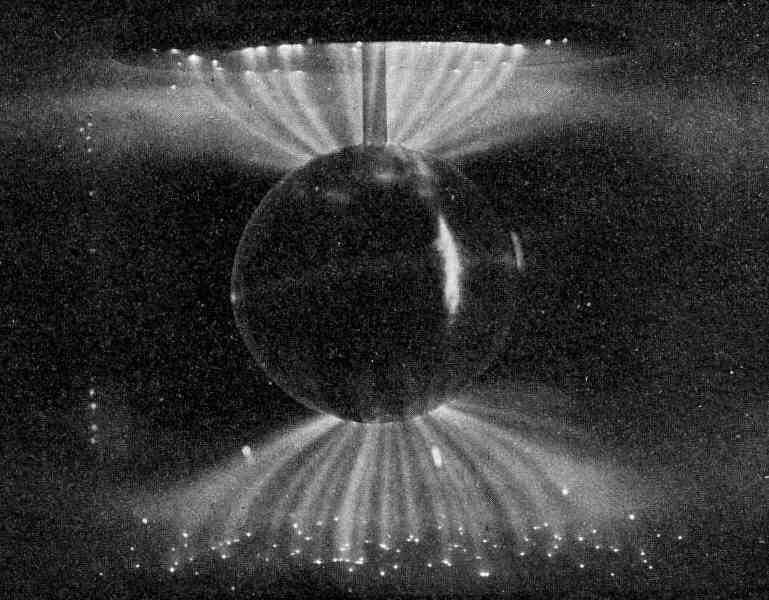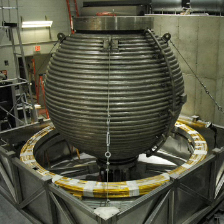The Earth’s magnetic field is quite a mystery. How is it generated? How does it remain so stable? We have known of the Earth’s magnetic field for hundreds of years and the humble compass has been telling us the direction of magnetic North Pole since the 12th Century. Animals use it for navigation and we have grown dependent on its existence for the same reason. What’s more, the magnetosphere gives us a powerful shield against the worst solar storm. Yet we still have little idea about the mechanisms generating this field deep in the core of the Earth. In the hope of gaining a special insight to the large-scale, planetary magnetic field, a geophysicist from the University of Maryland has built his very own baby Earth in his laboratory, and it will be spinning (liquid metal included) by the end of the year…

This story reminds me of a classic experiment carried out by Norwegian Kristian Birkeland at the turn of the 19th Century. In an attempt to understand the dynamic Aurora Borealis (Northern Lights), Birkeland experimentally proved that electrical currents could flow along magnetic field lines (a.k.a. Birkeland, or “field-aligned” currents, pictured left). This can be observed in nature as charged particles from the solar wind interact with the Earth’s magnetosphere and are then guided down to the Earth’s magnetic poles. As the particles flow into the upper polar atmosphere, they collide with atmospheric gases, generating a colourful light display called aurorae. However, this early experiment simulated a magnetic field; it did not model how the Earth generates it in the first place.
Now, in a laboratory in the University of Maryland, geophysicist Dan Lathrop is pursuing this mystery by building his very own scale version of the Earth (pictured top). The model is set up on apparatus that will spin the 10-foot diameter ball to an equatorial speed of 80 miles per hour. To simulate the Earth’s molten outer core, Lathrop will fill the sphere with molten metal. The whole thing will weigh in at 26 tonnes.
This is Lathrop’s third attempt at generating a scale model of the Earth’s magnetic field. The last two attempts were much smaller, so this large experiment had to be constructed by a company more used to engineering heavy-duty industrial equipment.
It is believed that the Earth’s molten outer core, starting 2,000 miles below the Earth’s crust, generates the global magnetic field. This “dynamo effect” is somehow created through the interaction of turbulent liquid iron flow (which is highly conductive) with the spin of the planet. In Lathrop’s model, he will be using another conductive liquid metal, sodium. Molten iron is too hot to maintain in this environment, sodium exists at a liquid phase at far lower temperatures (it has a melting point close to that of the boiling point of water, nearly 100°C), but there are some serious hazards associated with using sodium as an iron analog. It is highly flammable in air and is highly reactive with water, so precautions will have to be taken (for one, the sprinkler system has been disabled, water in the case of a sodium fuelled fire will only make things worse!). This whole experiment, although risky, is required as there is no direct way to measure the conditions in the outer core of the Earth.
“The conditions of the core are more hostile than the surface of the sun. It’s as hot as the surface of the sun but under extremely high pressures. So there’s no way to probe it, no imaginable technique to directly probe the core.” – Dan Lathrop
Spinning this heavy sphere should cause sustained turbulence in the flow of the liquid sodium and it is hoped a magnetic field can be generated. There are many puzzles this experiment hopes to solve, such as the mechanics behind magnetic polar shift. Throughout the Earth’s history there is evidence that the magnetic poles have switched polarity, prolonged spinning of the model may cause periodic magnetic pole reversal. Testing the conditions in the conductive liquid metal may shed some light on what influences this global pattern of polar shift.
This kind of experiment has been done before, but scientists have directed the flow of liquid metal through the use of pipes, but this model will allow the metal to naturally organize itself, creating its own turbulent flow. Whether or not this test generates a magnetic field it is unknown, but it should aid our understanding about how magnetism is generated inside the planets.
See the video at National Public Radio »
Source: National Public Radio


It’s possible that this experiment will also increase our understanding of why the phrase “Hey! Watch this ‘yall!” is so catchy.
Yeah, this thing is the best! I mean, what could be more awesome than a giant spinning ball of highly reactive molten sodium?! The potential for discovery is high, and the potential for disastrous accidents is not too far behind. In my books this make for one great experiment. It’s like going back to the string-and-stickytape science of yesteryear, where mentioning something as lame as OH&S would permanently damage your credibility as both a scientist and an upstanding human being. This may come off sounding sarcastic – but it’s not!
I agree, awesome… but I’d prefer not to be in the room when they switch this thing on!
Brilliant!
I wonder if the tidal forces of the moon will be taken into account, they must have an effect on the liquid core as the entire crust moves/distorts the crust therefore changing the “shape” of the liquid’s container.
This should be interesting: if it works , great, a better understanding of how the magnetosphere works.
If not, they may have to just RUUUUUUUUUUUUUUUUUUUUUUUN!!
The famous last words of so many people, “Hey everyone, watch this!”
But wait! Sodium is not diamagnetic like iron. Of course iron melts at too high a temperature to use it, but is liquid sodium truly analogous to a magnetic molten iron core at much higher pressures and temperatures? And what about the solid iron inner core? Certainly it’s gotta have an effect. I’m not sure this experiment is valid.
It’s going to be as exciting as when the world was absorbed into a micro black hole two weeks ago! Maybe the magnetosphere will be cancelled out due to the spinning of this model and cosmic rays will flood in and shut down the electrical apparatus of the CERN accelerator! Science is a BLAST!
No, really, that’s pretty cool. It reminds me of the transporter in THE FLY! Remember the transporter in CONTACT? Maybe this one will introduce Jody Foster to her dead dad too!
But this one will have the added effect of being on a spinning ball (the earth!) so will have to deal with added coriolis etc. I don’t think the tidal forces of the moon have much to do with that or the Earth’s magnetic field.
“But wait! Sodium is not diamagnetic like iron. Of course iron melts at too high a temperature to use it, but is liquid sodium truly analogous to a magnetic molten iron core at much higher pressures and temperatures? And what about the solid iron inner core? Certainly it’s gotta have an effect. I’m not sure this experiment is valid.”
It can help nail things down though. For instance, if the field is not produced, then they can hypothesize that the mechanism involved likely arises from a more esoteric effect than those able to be generated and modeled by the relatively simple setup. If the field is produced with similar characteristics to that of the Earth’s and they can pin down the mechanism that generates it, then that at the very least suggests it as a likely candidate for playing a significant role in the process within the Earth.
Modeling and experimentation is all about trying to reduce a highly complex system to a more manageable one by removing excess baggage – determining which effects and mechanisms are important and which are not… I’m sure that they realise that the model has serious limitations, and will consider this in their final analysis.
While interesting in and of itself, the experiment won’t come near representing a scale Earth unless the liquid contains a significant degree of ionization. A spinning conductor alone is not going to generate a magnetic field, there need to be separated charges in motion. Perhaps this experment includes magnetized particles in the liquid metal? I think the Birkeland experiment approach would have more to offer (using modern equipment and diagnostics), and is certainly easier to accomplish. And it will have a real, not simulated (as the article states), magnetic field, though the supposed mechanisms are different. The Birkeland approach was able to mimic the Earth (with auroras), Sun (predicted the solar equatorial torus) and Saturn (including rings, and that should give pause as we see more electrical effects such as ring spokes and many other “charged particle” phenomena at the ringed planet).
Why an iron core, or nickel or any heavy solid core.
Try a miniature planet with hydrogen enveloped with a basaltic shell, topped with a cracked rocky ‘ lithosphere’ sliding around on the shell.
Theory states it shouldn’t matter what metal is used, provided it is highly conductive. Iron itself is not magnetic, nor is nickle. Consensus is that turbulent flow of the metal in a molten state creates the polar differences for magnetism. Therefore, molten sodium (highly conductive itself) if moved correctly and turbulently; should create a magnetic field.
Metal in a molten state is quite different (at the molecular level) from when it is a solid.
Time will tell.
I have to wonder also about the lunar tidal effect on Earth dynamism. The center of mass of the Earth-Moon system is not the center of Earth, the berycenter of mutual rotation is a third of the way from the surface of Earth to the core. The migration of this center of mass may not be sufficient at this point in our mutual relationship to “cause earthquakes” directly, for example, but when the Moon was closer, the effect must have been exceptionally dynamic, including the possibility of the Moon’s presence being a driving force of tectonics. At various times in the ~ 4.527 Ga “relationship,” there may have been wild times and eccentricities, possibly accounting for equally wild emf flips… much of which will be clarified with further lunar exploration.
If this is so Aodhhan, then why don’t they use mercury and avoid the melting process?
I was wondering that too Mike.
There is also so the possibility of using a sodium potassium mix that is liquid at room temperature (look up NaK).
Sodium or NaK have a fire hazard & Mercury has toxicity problems, but if you would rather deal with the fire hazard than toxicity I would think NaK would be the least bad thing to deal with.
Ok, reading around the net, it starts to make sense all these 2012 predictions…
Lets say the magnetic flow drags/makes the magnetic fields around us, and at some point after 1000’s of years ‘flips’ over like any other gadget balancing on an edge.
Lets say, as we know, scientists got supristed of the suns sudden polar change happening after 6000 years instead of 11000 like they thought at first, and we do know the magnetic poles are not where they supposed to be, that’s new. I read about it this spring, and lets say the earth behaves as the sun, switching poles by turning it self in-side-out. We would have a problem ? Since the mayans predicted the suns poler change 3000 b.c. 🙂
I’m wrong ofcours, but an nice spin to whats going on !!!